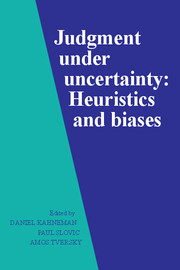Book contents
- Frontmatter
- Contents
- List of contributors
- Preface
- Part I Introduction
- Part II Representativeness
- Part III Causality and attribution
- 7 Popular induction: Information is not necessarily informative
- 8 Causal schemas in judgments under uncertainty
- 9 Shortcomings in the attribution process: On the origins and maintenance of erroneous social assessments
- 10 Evidential impact of base rates
- Part IV Availability
- Part V Covariation and control
- Part VI Overconfidence
- Part VII Multistage evaluation
- Part VIII Corrective procedures
- Part IX Risk perception
- Part X Postscript
- References
- Index
9 - Shortcomings in the attribution process: On the origins and maintenance of erroneous social assessments
Published online by Cambridge University Press: 05 May 2013
- Frontmatter
- Contents
- List of contributors
- Preface
- Part I Introduction
- Part II Representativeness
- Part III Causality and attribution
- 7 Popular induction: Information is not necessarily informative
- 8 Causal schemas in judgments under uncertainty
- 9 Shortcomings in the attribution process: On the origins and maintenance of erroneous social assessments
- 10 Evidential impact of base rates
- Part IV Availability
- Part V Covariation and control
- Part VI Overconfidence
- Part VII Multistage evaluation
- Part VIII Corrective procedures
- Part IX Risk perception
- Part X Postscript
- References
- Index
Summary
Introduction to attribution theory and attributional errors
Attribution theory and intuitive psychology
Attribution theory, in its broadest sense, is concerned with the attempts of ordinary people to understand the causes and implications of the events they witness. It deals with the “naive psychology” of people as they interpret their own behavior and the actions of others. The current ascendancy of attribution theory in social psychology thus culminates a long struggle to upgrade that discipline's conception of man. No longer the stimulus-reponse (S-R) automaton of radical behaviorism, promoted beyond the rank of information processor and cognitive consistency seeker, psychological man has at last been awarded a status equal to that of the scientist who investigates him. For in the perspective of attribution theory, people are intuitive psychologists who seek to explain behavior and to draw inferences about actors and about their social environments.
To better understand the perceptions and actions of this intuitive scientist we must explore his methods. First, like the academic psychologist, he is guided by a number of implicit assumptions about human nature and human behavior – for example, that the pursuit of pleasure and the avoidance of pain are ubiquitous and powerful human motives, or that conformity to the wishes and expectations of one's peers is less exceptional and less demanding of further interpretation than non-conformity. The lay psychologist, like the professional one, also relies heavily upon data, albeit data that rarely satisfy formal requirements regarding randomness or representativeness.
Information
- Type
- Chapter
- Information
- Judgment under UncertaintyHeuristics and Biases, pp. 129 - 152Publisher: Cambridge University PressPrint publication year: 1982
Accessibility standard: Unknown
Why this information is here
This section outlines the accessibility features of this content - including support for screen readers, full keyboard navigation and high-contrast display options. This may not be relevant for you.Accessibility Information
- 119
- Cited by
